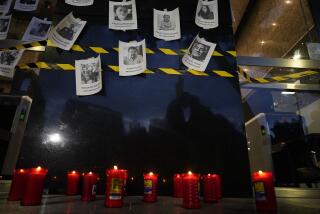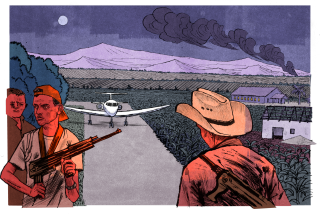Mexican drug lord hid in mountains, homes, sewers
The residence where Mexican drug lord Joaquin “El Chapo” Guzman apparently had been hiding is a tidy, whitewashed house with spike-topped wrought iron fencing, a heavy metal door and blackened windows.
It sits across from a high school and is surrounded by drainage canals that may have been part of a system officials said Guzman used as both a means of escape and to access a network of other homes.
Guzman was nothing if not discreet. “I thought the house was empty,” a neighbor told The Times on Sunday.
Guzman’s famous Houdini-style string of getaways ended early Saturday when Mexican marines, acting on U.S. intelligence, tracked him to an apartment just over 100 miles to the south in the seaside resort of Mazatlan. He had made a crucial mistake, sources said, using a satellite phone that eventually helped pinpoint his location.
He reportedly was sleeping with an AK-47 assault rifle but did not have time to grab it before the marines overpowered him in the predawn operation.
Guzman, one of the world’s leading drug traffickers and Mexico’s most-wanted billionaire fugitive, spent his first full day in an underground cell on Sunday at a maximum-security prison with other alleged traffickers with names like The Hummer.
Now in his mid-50s, he had eluded arrest for such a long time that he gained folk hero status. It is widely suspected that he paid off military, police and government officials to remain free while he steadily built his heroin, cocaine and marijuana empire.
The series of operations that finally ended in his arrest began in the second week of February, according to Mexican officials and Americans from the Drug Enforcement Administration and the Marshal’s Service.
Mexican authorities captured a lieutenant to Guzman’s right-hand man, Ismael “El Mayo” Zambada, and confiscated a collection of cellular telephones, the sources said. Starting in mid-February — days ahead of a state visit to Mexico by President Obama — Mexican marines staged a series of raids on numerous properties in Culiacan, hot on Guzman’s trail, said the sources, who requested anonymity because they were not authorized to speak to the media about the pursuit.
The phones led to two top henchmen in his operation, with code names El 19 and El 20. On Feb. 17, marines descended on the whitewashed house in Culiacan, the capital of Sinaloa state, birthplace of his powerful cartel. Guzman apparently barely escaped. Neighbors said the military staked out the place for two days.
But that’s when Guzman used the satellite phone, and U.S. intelligence agents were able to nail down its location.
“We could triangulate him, follow him wherever his phones were used,” one U.S. official told The Times.
Michael S. Vigil, a former top DEA official who had been briefed on the capture, confirmed that agents used a triangulation system to find Guzman, similar to what was employed in the 1993 pursuit and killing of Colombian kingpin Pablo Escobar. “But today the technology is first rate,” he said. “You can track someone within [7 1/2 yards] anywhere in the world.”
As Mexican and undercover U.S. agents raided the properties in Culiacan, they discovered a network of homes with steel-reinforced doors and hidden tunnels that led underground and sometimes through the city’s sewer system. They learned that Guzman was always a step ahead of them, however, disappearing down the tunnels before the authorities arrived.
Last week, there were unconfirmed reports that Guzman and Zambada were in Culiacan for a family party. He typically felt so “untouchable” that showing up in the state capital would not be out of the question.
Interrogating those being arrested, and using the phone tracking devices, the U.S. and Mexicans’ search for Guzman took them to a resort hotel in Mazatlan. At the same time, one of the key detainees began to talk and served as an informant to describe how Guzman had lately been venturing down from his nearby mountain hide-out.
“He was going through these tunnels and sewers, and we knew he was in Sinaloa country,” said one U.S. official. “The investigation lasted about a month, with Chapo living in a half-dozen houses and skirting between.
“He might have started to feel he’d be safer in jail than being on the run. The Zetas were hunting for him too,” said the official, referring to a rival drug cartel.
Residents at the seaside Miramar apartment complex in Mazatlan noticed a black-haired, mustachioed man moving in at midweek. They didn’t think much of it. Mazatlan sees lots of comings and goings, including an enormous population of wintering Americans and Canadians.
On Saturday, a little before 4 a.m., several dozen Mexican marines and other agents wearing black ski masks surrounded the 11-story Miramar apartment complex. They moved quickly to the fourth floor and found Guzman in an apartment there. They also raided an apartment on the fifth floor.
No shots were fired. By about 6:30 a.m., four men, three women and a baby were arrested with Guzman, who was quickly placed in a helicopter and taken to Mexico City, where he was paraded briefly before reporters.
Vigil said Guzman was sound asleep in bed, wearing just pants and no shirt, when he and his girlfriend were awakened as agents burst into the apartment.
“He was stoic. He didn’t say anything,” said Vigil, the DEA’s former special agent in charge in San Diego and the Caribbean, who also oversaw international operations. “He knew it was over.”
Guzman was “tired” of living in the mountains and “made a fatal mistake” of moving into the Culiacan and Mazatlan areas, Vigil said. “Those mountains are remote. I’ve been there. No TV. No entertainment. If you had millions and millions of dollars, you’d want some basic comforts.”
Vigil also said that Guzman had started traveling with just one or two bodyguards, so as not to raise suspicions about himself. “He was trying to get under the radar.”
Vigil described how several weeks ago when officials thought they were close to snatching the Sinaloa cartel leader, he vanished down an escape hatch in the bottom of a bathtub and fled through the sewers. “He knew how to get away.”
DEA agents have long said finding Guzman was not as difficult as making the decision to capture him. Given the possibility he might have been heavily protected, such an operation could have led to a bloodbath that no one wanted, DEA officials told The Times.
It remains unclear why President Enrique Peña Nieto, who generally has not wanted to confront cartel leaders the way his predecessor did, authorized the operation to capture Guzman.
Some Mexican commentators suggested that the president, facing low domestic approval ratings in the polls, was looking for a way to demonstrate his dedication to security issues. Capturing Guzman, by far the top prize in a drug war that has claimed tens of thousands of lives, would serve to counter rumors that Peña Nieto was soft on the Sinaloa cartel and had made a deal of convenience with Guzman.
It is also possible, several experts suggested, that the capture of Guzman was handed to the president as a fait accompli, given how successful the Mexican marines have been. More than the rest of the Mexican military, they work most closely with their U.S. counterparts and have been credited with some of the most important victories in the drug war.
“Peña Nieto does not focus on security the way [previous President Felipe] Calderon did,” said George Grayson, an expert on the Mexican drug war at the College of William & Mary in Virginia. “The Mexican navy has gotten very good at this — phone eavesdropping, drones — with U.S. cooperation, and I don’t think Peña Nieto” was controlling the operation.
Guzman has long been wanted by U.S. authorities, who offered a $5-million bounty for information leading to his capture.
Vigil said the Department of Justice will soon decide on the best venue for prosecuting Guzman in the U.S. — Chicago, San Diego or El Paso — to get him the harshest sentence possible. But he doubted that Peña Nieto’s government would be in a hurry to turn him over.
“He’s basically a human trophy,” he said, “the crown jewel of the new presidential administration.”
Wilkinson reported from Mexico City, Serrano from Washington and Fausset from Culiacan. Times news assistant Cecilia Sanchez in Mexico City contributed to this report.
t from Culiacan. Times news assistant Cecilia Sanchez in Mexico City contributed to this report.
More to Read
Start your day right
Sign up for Essential California for news, features and recommendations from the L.A. Times and beyond in your inbox six days a week.
You may occasionally receive promotional content from the Los Angeles Times.








